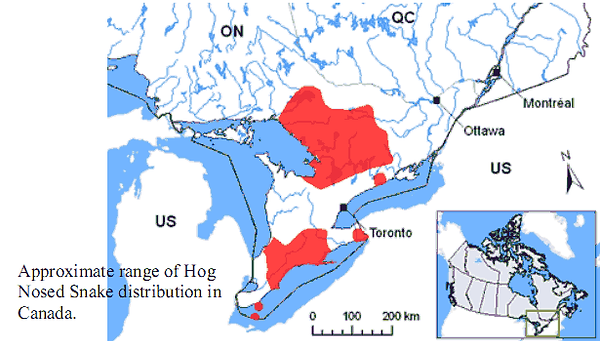
Resources | Coastal Flora and Fauna
Eastern Hog Nosed Snake
The Eastern Hog-nosed Snake is protected under the federal Species at Risk Act (SARA) and the Ontario Fish and Wildlife Conservation Act. Under this Act, it is prohibited to kill, harass, or capture this species. Populations occur in Pinery, Rondeau, and Long Point provincial parks.
The Eastern Hog-nosed snake (Heterodon platirhinos) is sometimes mistaken for a cobra because when it is threatened it rears back and flattens its neck out. It may strike out if harassed but rarely bites, and it is not poisonous. Its similarity to a rattle-snake causes people to think that it is. If its aggressive behaviour fails to ward off a potential threat, the snake will play dead, writhing about and finally rolling over on its back with its tongue out. It is commonly and mistakenly considered dangerous and killed.
It gets its common name from long scales on its nose which give it an upturned snout. Old individuals can be one metre long and their bodies are thick. They prefer sandy, well-drained habitats such as beaches and dry woods because this is where they lay their eggs in burrows and where they hibernate.
Eastern Hog-nosed Snakes in shoreline areas often rely on driftwood and other ground cover in beach and beach dune habitats, where toads, their prey of choice, are found.

Special points of Interest:
-
Non venomous
-
Threatened species.
-
Under Ontario's Endangered Species Act 2007, it is illegal to harass, capture, buy, sell, possess, or kill the Eastern Hog-nosed Snake. This species is also protected under Ontario's Fish and Wildlife Conservation Act.
-
In southwestern Ontario, the species has suffered extensive habitat loss from agriculture and the rapid increase in housing development. In that area, the species faces several threats, particularly increased mortality and severe habitat fragmentation caused by the expanding road network and increased traffic. In addition, the species is highly mobile and moves about a lot (for a snake); this increases the risk of mortality associated with roads.
-
Found in a variety of habitats – prefers sandy areas where its main food source, toads, are found.
How You Can Help:
You are in no danger from the eastern hog-nosed snake. Report sightings to the Ontario Ministry of Natural Resources.
Leave snakes and their habitat alone. Inform others about the plight of the Eastern Hog-nosed Snake.
Please remember that they are a legally protected species.

.png)